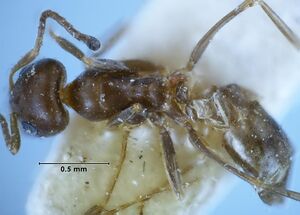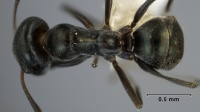Iridomyrmex mjobergi
| Iridomyrmex mjobergi | |
|---|---|

| |
| Scientific classification | |
| Kingdom: | Animalia |
| Phylum: | Arthropoda |
| Class: | Insecta |
| Order: | Hymenoptera |
| Family: | Formicidae |
| Subfamily: | Dolichoderinae |
| Tribe: | Leptomyrmecini |
| Genus: | Iridomyrmex |
| Species: | I. mjobergi |
| Binomial name | |
| Iridomyrmex mjobergi Forel, 1915 | |
Away from settled areas, I. mjobergi probably shares with Iridomyrmex suchieri and Iridomyrmex chasei the title of most populous Iridomyrmex species. This taxon can be found in all Australian states, and even extends into New Guinea. Colonies sampled by Brian Heterick have been found nesting in the soil or under stones. At Mt. Tomah (New South Wales) a nest was found by in an aluminium beer can! This species climbs trees in search of nectar, and, presumably, honeydew, and has been taken from Banksia flowers. Workers are not aggressive, and will actively conceal themselves in litter when efforts are made to collect them. This behaviour in the field separates them from more aggressive species like I. chasei, which attempt to attack the forceps or other collecting implements.
Identification
Iridomyrmex mjobergi, along with Iridomyrmex dromus and Iridomyrmex minor, is included in the three most taxonomically troublesome Iridomyrmex taxa. What makes I. mjobergi particularly difficult is its bland and uninformative appearance, which can easily lead to it being confused with over half-a-dozen other Iridomyrmex species. Typically, I. mjobergi is a small-medium to small, coppery, brown ant, although the rare nest (South Australia) contains orange-and-brown workers. Workers from mesic areas of the south-west and south-east of the continent are on average larger and hairier than their conspecifics in drier or more northerly areas. In the Northern Territory and northern parts of Western Australia, South Australia and Queensland, populations of very small, truncate workers occur, in which the propodeum becomes progressively more narrowly rectangular in appearance across geographic distance. These are connected with the larger morphs by a continuum of forms, in which variation has to be examined across a large geographic scale to be properly understood. Conspicuous iridescence is mostly absent, but uniform yellowish-green reflections can be seen in some populations near the southern coast of Western Australia. As understood here, this species always lacks a well-defined line or aggregation of small, erect setae on the posterior margin of the head when seen in full-face view (although there may be up to a half dozen randomly distributed setae in ants from Kangaroo Island and adjacent parts of the South Australian mainland), thus enabling it to be separated from Iridomyrmex splendens, and its yellow to pale orange mandibles also enable relatively glabrous forms to be distinguished from the rarer and localised Iridomyrmex meridianus (dark mandibles). In difficult cases, the size of the eye in individuals of the same size (overall, EL 0.13–0.24 in I. mjobergi, compared with 0.16–0.19 in I. splendens) is often helpful in pulling apart workers of I. splendens and I. mjobergi. There is also a phenotype that is structurally indistinguishable from Iridomyrmex suchieri. However, that ant has a glabrous mesosoma, and the posterior margin of the head is also usually lacking in erect setae (a solitary tiny seta may be present), thus enabling it to be distinguished from I. suchieri. The planar appearance of the posterior margin of the head in full-face view also distinguishes hairier, eastern populations of this ant from Iridomyrmex victorianus that have a concave posterior margin of the head. Finally, its longer antennal scape separates northern populations of I. mjobergi from other small Iridomyrmex found in the more tropical areas (most notably, Iridomyrmex difficilis and Iridomyrmex hertogi). Typically, I. mjobergi workers have a pair of well-separated, tiny, erect setae on the posterior margin of the head. Rarely, the eye may be moderately asymmetrical, leading to comparison with some other forms with asymmetrical eyes, such as I. dromus and Iridomyrmex cupreus, but I. dromus has a hairier mesosomal dorsum and almost always a longer antennal scape, while I. cupreus has hairy tibiae (always glabrous in I. mjobergi).
Keys including this Species
Distribution
Latitudinal Distribution Pattern
Latitudinal Range: 22.5045° to -37.81666946°.
| North Temperate |
North Subtropical |
Tropical | South Subtropical |
South Temperate |
- Source: AntMaps
Distribution based on Regional Taxon Lists
Australasian Region: Australia (type locality).
Indo-Australian Region: New Guinea.
Distribution based on AntMaps
Distribution based on AntWeb specimens
Check data from AntWeb
Countries Occupied
| Number of countries occupied by this species based on AntWiki Regional Taxon Lists. In general, fewer countries occupied indicates a narrower range, while more countries indicates a more widespread species. |

|
Biology
Castes
Worker
  
| |
| Worker. . | Owned by Australian National Insect Collection. |
  
| |
| Syntype of Iridomyrmex mjobergi. Worker. . | |
Nomenclature
The following information is derived from Barry Bolton's Online Catalogue of the Ants of the World.
- mjobergi. Iridomyrmex mjobergi Forel, 1915b: 77 (w.) AUSTRALIA. See also: Heterick & Shattuck, 2011: 108.
Type Material
- Lectotype (designated by Heterick & Shattuck, 2011), worker, Kimberley district, Western Australia, Australia, Musee d'Histoire Naturelle Genève.
- Paralectotype (designated by Heterick & Shattuck, 2011), 6 workers, Kimberley district, Western Australia, Australia, Musee d'Histoire Naturelle Genève.
- Paralectotype (designated by Heterick & Shattuck, 2011), 1 worker, Kimberley district, Western Australia, Australia, Naturhistorisches Museum, Basel.
- Paralectotype (designated by Heterick & Shattuck, 2011), worker(s), Ravenshoe (as Cedar Creek) and Malanda, Queensland, Australia; (not examined by Heterick & Shattuck, 2011).
Note: The type material from the Kimberley district contains a mix of both I. mjobergi and I. difficilis specimens. With the lectotype designated by Heterick & Shattuck (2011) the name of this taxon is secured and the holotype selected for I. difficilis provides a name of that taxon.
Description
Worker Description. Head. Posterior margin of head planar to weakly concave; erect setae on posterior margin in full-face view, present in small aggregations on one or both sides of posterior margin of head, or in full-face view, present singly or as a couple of setae on either side of posterior margin of head, or absent; sides of head noticeably convex; erect genal setae absent from sides of head in full-face view (one to a few small setae may be present near mandibular insertion). Ocelli absent; in full-face view, eyes set at about midpoint of head capsule; in profile, eye set anteriad of head capsule; eye asymmetrical, curvature of inner eye margin more pronounced than that of its outer margin. Frontal carinae convex; antennal scape surpassing posterior margin of head by 1–2 x its diameter. Erect setae on scape absent, except at tip; prominence on anteromedial clypeal margin projecting as triangular spur; mandible regularly triangular with oblique basal margin; long, curved setae on venter of head capsule absent. Mesosoma. Pronotum moderately and evenly curved over its length. Erect pronotal setae sparse to absent. Mesonotum straight, or evenly curved. Erect mesonotal setae sparse (6 or fewer) and bristly. Mesothoracic spiracles always inconspicuous; propodeal dorsum protuberant, or smoothly and evenly convex, or straight and short (equal in length to propodeal declivity), or tapered posteriad; placement of propodeal spiracle posteriad and near propodeal declivity; propodeal angle present as a bluntly defined right angle, the dorsal and declivitous propodeal faces never separated by a carina, or weakly present or absent, the confluence of the dorsal and declivitous propodeal faces indicated, if at all, by an undulation. Erect propodeal setae lacking or very minute (one or two tiny setae present). Petiole. Dorsum of node convex; node thin, scale-like, orientation more-or-less vertical. Gaster. Non- marginal erect setae of gaster present or absent on first gastral tergite; marginal erect setae of gaster present on first tergite, or absent on first tergite. General characters. Allometric differences between workers of same nest absent. Colour generally medium to dark brown, but rarely may have orange mesosoma with darker head and gaster. Colour of erect setae pale yellow.
Measurements. Worker (n = 11)—CI 82–88; EI 27–30; EL 0.16–0.24; EW 0.12–0.19; HFL 0.66–1.18; HL 0.63–0.98; HW 0.56–0.85; ML 0.69–1.22; MTL 0.47–0.80; PpH 0.09–0.17; PpL 0.31–0.52; SI 92–108; SL 0.5 1– 0.90.
References
- Forel, A. 1915b. Results of Dr. E. Mjöbergs Swedish Scientific Expeditions to Australia 1910-13. 2. Ameisen. Ark. Zool. 9(1 16: 1-119 (page 77, worker described)
- Heterick, B.E. & Shattuck, S.O. 2011. Revision of the ant genus Iridomyrmex (Hymenoptera: Formicidae). Zootaxa 2845: 1-175.
- Heterick, B.E. 2021. A guide to the ants of Western Australia. Part I: Systematics. Records of the Western Australian Museum, Supplement 86, 1-245 (doi:10.18195/issn.0313-122x.86.2021.001-245).
- Heterick, B.E. 2022. A guide to the ants of Western Australia. Part II: Distribution and biology. Records of the Western Australian Museum, supplement 86: 247-510 (doi:10.18195/issn.0313-122x.86.2022.247-510).
- Majer, J.D., Castalanelli, M.A., Ledger, J.L., Gunawardene, N.R., Heterick, B.E. 2018. Sequencing the ant fauna of a small island: Can metagenomic analysis enable faster identification for routine ant surveys? Sociobiology 65, 422-432 (doi:10.13102/sociobiology.v65i3.2885).
References based on Global Ant Biodiversity Informatics
- Baroni Urbani C. 1977. Katalog der Typen von Formicidae (Hymenoptera) der Sammlung des Naturhistorischen Museums Basel (2. Teil). Mitt. Entomol. Ges. Basel (n.s.) 27: 61-102.
- CSIRO Collection
- Fisher J., L. Beames, B. J. Rangers, N. N. Rangers, J. Majer, and B. Heterick. 2014. Using ants to monitor changes within and surrounding the endangered Monsoon Vine Thickets of the tropical Dampier Peninsula, north Western Australia. Forest Ecology and Management 318: 7890.
- Heterick B. E. 2013. A taxonomic overview and key to the ants of Barrow Island, Western Australia. Records of the Western Australian Museum Supplement 83: 375-404.
- Heterick B. E., B. Durrant, and N. R. Gunawardene. 2010. The ant fauna of the Pilbara Bioregion, Western Australia. Records of the Western Australian Museum, Supplement 78: 157-167.
- Heterick B. E., and S. Shattuck. 2011. Revision of the ant genus Iridomyrmex (Hymenoptera: Formicidae). Zootaxa 2845: 1-174.
- Heterick, B., and S. O. Shattuck. "Revision of the ant genus Iridomyrmex (Hymenoptera: Formicidae)." Zootaxa 2845 (2011): 1-174.
- Shattuck S. O. 1994. Taxonomic catalog of the ant subfamilies Aneuretinae and Dolichoderinae (Hymenoptera: Formicidae). University of California Publications in Entomology 112: i-xix, 1-241.
- Taylor R. W. 1987. A checklist of the ants of Australia, New Caledonia and New Zealand (Hymenoptera: Formicidae). CSIRO (Commonwealth Scientific and Industrial Research Organization) Division of Entomology Report 41: 1-92.

